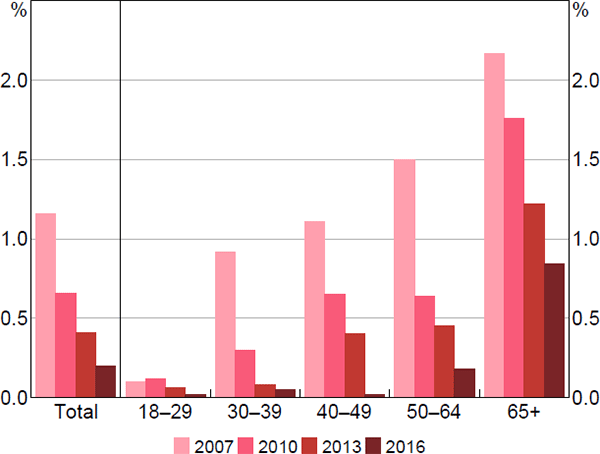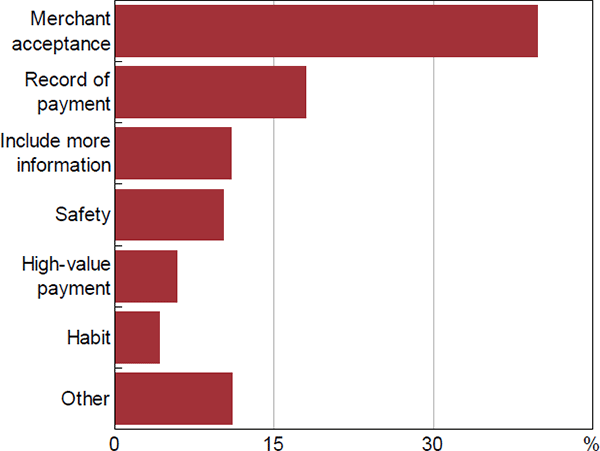RDP 2017-04: How Australians Pay: Evidence from the 2016 Consumer Payments Survey 6. Personal Cheques
July 2017
The use of personal cheques continued to decline, with cheques accounting for only 0.2 per cent of payments made by participants in the 2016 survey, compared with 0.4 per cent in 2013 and 1.2 per cent in 2007. Consistent with this, the share of respondents that reported making at least one personal cheque payment in the year prior to the survey fell to 12 per cent from around 20 per cent in 2013. While analysis of cheque use is complicated by the small number of cheque payments recorded in the survey, the broad results provide further evidence of the long-term decline in the use of cheques.[27]
Cheque use remains concentrated among older Australians; around 70 per cent of the number of cheque payments recorded in the 2016 CPS were made by participants aged 65 and over. Consistent with this, around half of the respondents that made cheque payments during the week reported that they had retired from the workforce. Nonetheless, fewer cheques are being written by consumers of all ages (Figure 21).

Source: RBA calculations, based on data from Colmar Brunton, Ipsos and Roy Morgan Research
As in previous surveys, personal cheques were mainly used for larger expenditures such as household services, bills or holidays. Accordingly, cheque payments have a higher median value ($135) than cash or card payments. Relatedly, half of cheque payments recorded during the week were made by mail. It is likely that some consumers use cheques for remote payments because alternative payment methods are not readily available. Over one-third of respondents that made cheque payments did not use the internet on a regular basis.
As mentioned, 12 per cent of survey respondents reported making at least one personal cheque payment in the year prior to the survey. A large share of these respondents reported that they had done so because some merchants prefer to be paid by cheque or because there was no alternative for that particular type of payment (Figure 22). This suggests that in a number of cases respondents would have preferred to use another payment method but used cheques due to influence from the merchant. Consistent with this, only a very small number of consumers indicated a preference for cheque payments over other payment methods. However, some respondents also reported that they use cheques because cheques provide a useful record of the payment. Other respondents also valued the safety of cheque payments and that cheques allow them to include more information with the payment (by attaching documents).

Notes: Per cent of respondents who made a cheque payment in the past year; ‘Other’ includes low cost, avoiding surcharges and useful for sending by post
Source: RBA calculations, based on data from Ipsos
Footnote
See Richards (2016) and Tellez (2017) for a discussion of the trends in cheque use. [27]